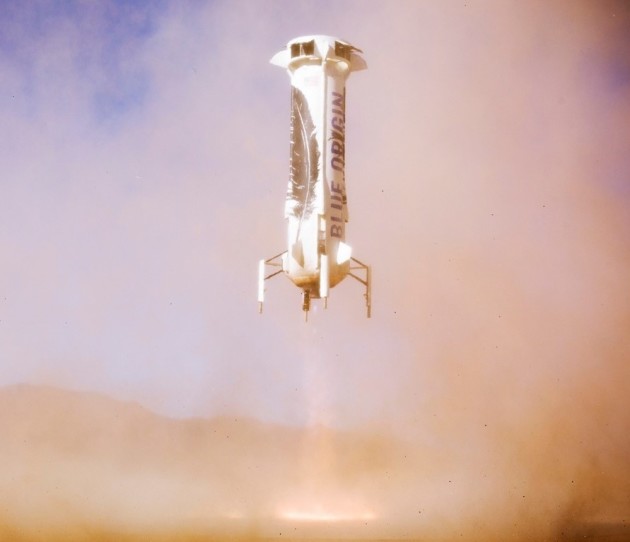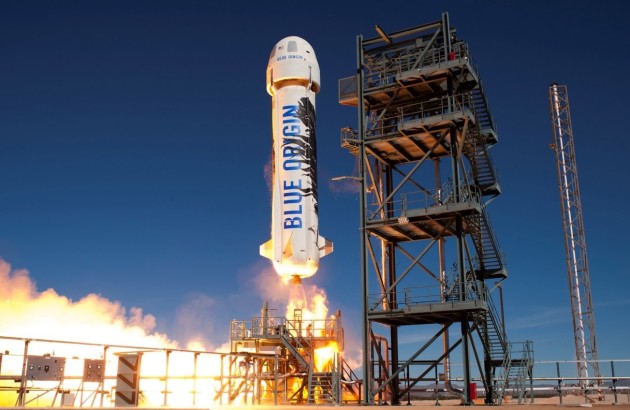Amazon founder Jeff Bezos’ Blue Origin space venture sent up its New Shepard suborbital spaceship on another flight test to outer-space altitudes today, and brought it back to a safe landing.
The uncrewed flight at Bezos’ West Texas test facility arguably marks the first time that a reusable rocket designed for a vertical landing proved to be actually reusable for space missions.
There are caveats to that claim, to be sure: The SpaceShipOne rocket plane, the X-15 and NASA’s space shuttles have all demonstrated reusability after going into space. Those craft landed horizontally, like an airplane, rather than vertically. In addition, test rockets flown by the DC-X program as well as Masten Space Systems, Armadillo Aerospace and SpaceX have been reused after taking vertical hops. However, those rockets stuck to altitudes below 100 kilometers (62 miles), the internationally accepted boundary of outer space.
Despite all the caveats, Blue Origin’s feat marks a significant step toward flying reusable rocket ships on suborbital space trips on a commercial basis, for tourism as well as for research.
New Shepard blastoff
Blue Origin’s New Shepard prototype spaceship blasts off from its Texas launch pad. (Credit: Blue Origin)
“Though wings and parachutes have their adherents and their advantages, I’m a huge fan of rocket-powered vertical landing. Why? Because — to achieve our vision of millions of people living and working in space — we will need to build very large rocket boosters. And the vertical landing architecture scales extraordinarily well,” Bezos said in a post-flight statement on Blue Origin’s website, titled “Launch. Land. Repeat.”
The prototype spaceship is the same one that demonstrated a vertical landing after flying beyond 100 kilometers last November. This time, New Shepard rose to a height of 101.7 kilometers (63.2 miles, or 333,582 feet), Blue Origin said. A video of the flight test shows the craft’s empty passenger capsule floating back down at the end of a parachute, and the propulsion module firing its thrusters to make an upright landing at a descent rate of 4.2 mph.
Bezos went into geek mode to explain how his rocket team handled reusability:
“Data from the November mission matched our preflight predictions closely, which made preparations for today’s re-flight relatively straightforward. The team replaced the crew capsule parachutes, replaced the pyro igniters, conducted functional and avionics checkouts, and made several software improvements, including a noteworthy one. Rather than the vehicle translating to land at the exact center of the pad, it now initially targets the center, but then sets down at a position of convenience on the pad, prioritizing vehicle attitude ahead of precise lateral positioning. It’s like a pilot lining up a plane with the centerline of the runway. If the plane is a few feet off center as you get close, you don’t swerve at the last minute to ensure hitting the exact midpoint. You just land a few feet left or right of the centerline. Our Monte Carlo sims of New Shepard landings show this new strategy increases margins, improving the vehicle’s ability to reject disturbances created by low-altitude winds.”

Low-cost rocket reusability is considered a key requirement for making space travel more affordable. SpaceX succeeded with a landing of its Falcon 9 rocket’s first-stage booster in December, and is expected to demonstrate reusability for orbital launches as early as this year. As SpaceX founder Elon Musk pointed out at the time, landing a rocket after an orbital launch is much more difficult than landing it after a suborbital flight.
Bezos made it clear that New Shepard’s suborbital missions were just the start:
“Since New Shepard is the smallest booster we will ever build, this carefully choreographed dance atop our plume will just get easier from here. We’re already more than three years into development of our first orbital vehicle. Though it will be the small vehicle in our orbital family, it’s still many times larger than New Shepard. I hope to share details about this first orbital vehicle this year.”
If Blue Origin’s development plan proceeds as Bezos hopes, commercial suborbital flights could begin within two years, using the company’s hydrogen-powered BE-3 engine. The company has not yet announced how much those flights would cost. At the same time, Blue Origin is developing a methane-powered BE-4 engine that could be used on its own orbital-class rockets as well as United Launch Alliance’s reusable Vulcan rocket.
Blue Origin capsule with parachutes
The New Shepard’s passenger capsule floats down to the ground at the end of parachutes after separation from the propulsion module. The capsule is designed to hold up to six passengers, but for these flight tests, the capsule carries no riders. (Credit: Blue Origin)
